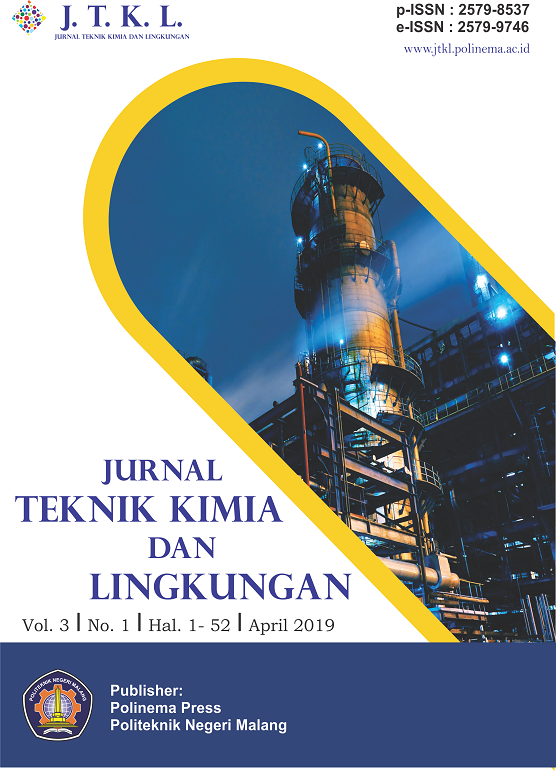Regenerasi In-Situ Adsorben Karbon Aktif Tipe Granul dengan Metode Termal
DOI:
https://doi.org/10.33795/jtkl.v3i1.91%20Keywords:
activated carbon, adsorption, carbon dioxide, desorption, in-situ regeneration, temperatureAbstract
Produk biogas memiliki spesifikasi yang masih perlu ditingkatkan (mengandung metana, CH4 50-70%, dan karbon dioksida, CO2 30 – 49%), agar dapat bersaing dengan gas alam, yaitu lebih dari 98% metana. Metode pemurnian melalui adsorpsi CO2 paling banyak diterapkan, karena tidak memerlukan biaya tinggi, jika dibandingkan teknologi pemisahan konvensional lain. Tetapi, media adsorben karbon aktif akan mengalami kejenuhan dalam waktu tertentu. Salah satu metode yang dapat digunakan untuk meregenerasi karbon aktif yang jenuh oleh CO2 yaitu dengan peningkatan temperatur melalui metoda termal. Pada penelitian ini dilakukan regenerasi in-situ dengan peningkatan temperatur karbon aktif di dalam kolom adsorpsi-desorpsi, dengan alat dapat mengakomodasi tiga pola operasi, yaitu adsorpsi, regenerasi/desorpsi, dan pengosongan gas. Alat terdiri atas kolom yang dilengkapi perpipaaan, blower pendorong udara, heater dan thermostat untuk pemanas dan pengatur temperatur udara. Hasil uji alat menunjukkan bahwa durasi proses adsorpsi hingga mencapai kejenuhan adalah 30 menit pada siklus pertama dan 40 menit pada siklus kedua. Selanjutnya, durasi proses desorpsi dari siklus pertama hingga ketiga menunjukkan peningkatan linier, dipengaruhi oleh temperatur udara pemanas, dengan penurunan konsentrasi Ca(OH)2 hingga masih menunjukkan tren peningkatan. Setelah dilakukan tiga siklus proses adsorspi-desorpsi didapatkan bahwa performa dari karbon aktif masih belum mengalami penurunan kapasitas.
siklus proses adsorspi-desorpsi didapatkan bahwa performa dari karbon aktif masih belum mengalami penurunan kapasitas.
Kata kunci: adsorpsi, desorpsi, karbon aktif, karbon dioksida, regenerasi in-situ, temperatur
ABSTRACT
Biogas have certain specifications that need to be improved (contain methane, CH4, 50-70%, and carbon dioxide, CO2, 30-49%), in order to compete with natural gas ( >98% methane). The adsorption of CO2 is the most widely applied to purify biogas since it considered as low cost, in terms of energy supply and raw materials. However, activated carbon adsorbent will be saturated and must be regenerated. One of the methods that can be used to regenerate CO2-saturated activated carbon is using thermal method. In this research, the in-situ regeneration was carried out by increasing temperature of the activated carbon in adsorption-desorption column, which accommodate three operating patterns, namely adsorption, regeneration/desorption, and gas discharge. The tool consists of columns, piping, blower, heater and thermostat for air heating and controlling temperature. The result showed that the saturation time was 30 minutes and 40 minutes, respectively in 1st and 2nd cycle. The duration of the desorption from the 1st to 3rd cycle showed a linear trend, influenced by heating air temperature. And the reduction in Ca(OH)2 concentration still showed increasing trend after three adsorption-desorption cycles carried out, so the performance or adsorption capacity of activated carbon had not yet been decreased.
References
R. Zhang, Biogas Production Technologies, Colorado: Biogas and Fuel Cell Workshop, National Renewable Energy Laboratory, 2012.
Soil and Science Water Department of University of Florida, "University of
Florida," 20 Maret 2018. [Online]. Available:http://biogas.ifas.ufl.edu/us es.asp.
M. P. S. Santos, C. A. Grande, and A.
E. Rodrigues, Pressure Swing Adsorption for Biogas Upgrading. Effect of Recycling Streams in Pressure Swing Adsorption Design, Ind. Eng. Chem. Res., vol. 50, no. 2, hal. 974–985, 2011.
P. A. Cremonez, A. Feiden, E. d. Rossi, W. C. Nadaleti and J. Antonelli, Main technologies available for biogas purification, Applied Research & Agrotecnology, vol. 7, no. 1, hal 113- 119, 2014.
E. Chen, K. Rolin and Z. Stillman, Activated Carbon-based Carbon Dioxide Adsorption Process, Senior Design Reports, Philadelphia, 2017.
Fischer and V. Marco, In situ electrochemical regeneration of activated carbon, Ph.D. Dissertation, Faculty of Mathematics and Natural Sciences, University of Groningen, Groningen, Netherlands, 2001.
A. Kurniawan, Pembuatan dan Pengujian Alat Pemurnian Biogas menggunakan Metode Adsorpsi dengan Variasi Ukuran Karbon Aktif sebagai Adsorben, Tugas Akhir, Jurusan Teknik Konversi Energi, Politeknik Negeri Bandung, Bandung, 2016.
Kurniawan, Pembuatan dan Pengujian Kolom Adsorpsi Biogas menggunakan Campuran Adsorben Karbon Aktif dan Zeolit, Tugas Akhir, Jurusan Teknik Konversi Energi, Politeknik Negeri Bandung, Bandung, 2017.
Y. Suprianti, Pemurnian Biogas untuk meningkatkan Nilai Kalor melalui Adsorpsi Dua Tahap Susunan Seri dengan Media Karbon Aktif, Elkomika, vol. 4, no. 2, hal. 185-196, 2016.
Y. R. Pangestu, Pembuatan dan Pengujian Kolom Adsorpsi Biogas menggunakan Adsorben Variasi Campuran Bentuk Karbon Aktif, Tugas Akhir, Jurusan Teknik Konversi Energi, Politeknik Negeri Bandung, Bandung, 2018.
W. L. McCabe, J. C. Smith and P. Harriott, Unit Operations of Chemical Engineering, McGraw-Hill, Inc., 1993.
V. Amicarelli, G. Baldassarre and L. Liberti, Investigation of Low- Temperature Regeneration of Activated Carbon, Journal of Thermal Analysis, vol. 18, hal. 155-160, 1980.
A. R. Balakrishnan and D. C. T. Pei, Heat Transfer in Gas-Solid Packed Bed Systems. 2. The Conduction Mode, Industrial & Engineering Chemistry Process Design and Development, vol. 18, no. 1, hal. 40- 46, 1979.
Downloads
Published
Issue
Section
License
Copyright (c) 2019 Yanti Suprianti, Annisa Syafitri Kurniasetyawati

This work is licensed under a Creative Commons Attribution-NonCommercial 4.0 International License.







